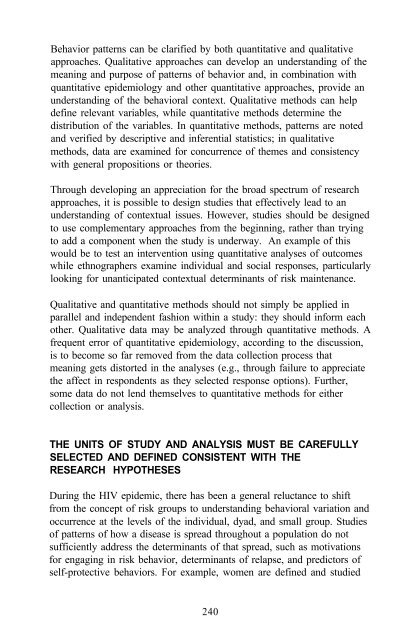The Context of HIV Risk Among Drug Users and Their Sexual Partners
The Context of HIV Risk Among Drug Users and Their Sexual Partners
The Context of HIV Risk Among Drug Users and Their Sexual Partners
You also want an ePaper? Increase the reach of your titles
YUMPU automatically turns print PDFs into web optimized ePapers that Google loves.
Behavior patterns can be clarified by both quantitative <strong>and</strong> qualitative<br />
approaches. Qualitative approaches can develop an underst<strong>and</strong>ing <strong>of</strong> the<br />
meaning <strong>and</strong> purpose <strong>of</strong> patterns <strong>of</strong> behavior <strong>and</strong>, in combination with<br />
quantitative epidemiology <strong>and</strong> other quantitative approaches, provide an<br />
underst<strong>and</strong>ing <strong>of</strong> the behavioral context. Qualitative methods can help<br />
define relevant variables, while quantitative methods determine the<br />
distribution <strong>of</strong> the variables. In quantitative methods, patterns are noted<br />
<strong>and</strong> verified by descriptive <strong>and</strong> inferential statistics; in qualitative<br />
methods, data are examined for concurrence <strong>of</strong> themes <strong>and</strong> consistency<br />
with general propositions or theories.<br />
Through developing an appreciation for the broad spectrum <strong>of</strong> research<br />
approaches, it is possible to design studies that effectively lead to an<br />
underst<strong>and</strong>ing <strong>of</strong> contextual issues. However, studies should be designed<br />
to use complementary approaches from the beginning, rather than trying<br />
to add a component when the study is underway. An example <strong>of</strong> this<br />
would be to test an intervention using quantitative analyses <strong>of</strong> outcomes<br />
while ethnographers examine individual <strong>and</strong> social responses, particularly<br />
looking for unanticipated contextual determinants <strong>of</strong> risk maintenance.<br />
Qualitative <strong>and</strong> quantitative methods should not simply be applied in<br />
parallel <strong>and</strong> independent fashion within a study: they should inform each<br />
other. Qualitative data may be analyzed through quantitative methods. A<br />
frequent error <strong>of</strong> quantitative epidemiology, according to the discussion,<br />
is to become so far removed from the data collection process that<br />
meaning gets distorted in the analyses (e.g., through failure to appreciate<br />
the affect in respondents as they selected response options). Further,<br />
some data do not lend themselves to quantitative methods for either<br />
collection or analysis.<br />
THE UNITS OF STUDY AND ANALYSIS MUST BE CAREFULLY<br />
SELECTED AND DEFINED CONSISTENT WITH THE<br />
RESEARCH HYPOTHESES<br />
During the <strong>HIV</strong> epidemic, there has been a general reluctance to shift<br />
from the concept <strong>of</strong> risk groups to underst<strong>and</strong>ing behavioral variation <strong>and</strong><br />
occurrence at the levels <strong>of</strong> the individual, dyad, <strong>and</strong> small group. Studies<br />
<strong>of</strong> patterns <strong>of</strong> how a disease is spread throughout a population do not<br />
sufficiently address the determinants <strong>of</strong> that spread, such as motivations<br />
for engaging in risk behavior, determinants <strong>of</strong> relapse, <strong>and</strong> predictors <strong>of</strong><br />
self-protective behaviors. For example, women are defined <strong>and</strong> studied<br />
240
















